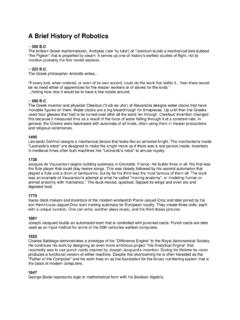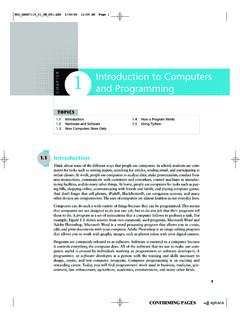Transcription of AC - mu notes
1 AC_____ Preamble The revised and restructured curriculum for the Three-year integrated course is systematically designed considering the current industry needs in terms of skills sets demanded under new technological environment. It also endeavours to align the programme structure and course curriculum with student aspirations and corporate expectations. The proposed curriculum is more contextual, industry affable and suitable to cater the needs of society and nation in present day context. Second year of this course is about studying core computer science subjects. Theory of Computation course provides understanding of grammar, syntax and other elements of modern language designs. It also covers developing capabilities to design formulations of computing models and its applications in diverse areas.
2 The course in Operating System satisfies the need of understanding the structure and functioning of system. Programming holds key indispensable position in any curriculum of Computer Science. It is essential for the learners to know how to use object oriented paradigms. There is also one dedicated course Android Developer Fundamentals as a skill enhancement catering to modern day needs of Mobile platforms and applications. The syllabus has Database Systems courses in previous semesters. The course in Database Management Systems is its continuation in third semester. The course has objectives to develop understanding of concepts and techniques for data management along with covers concepts of database at advance level. The course of Combinatorics and Graph Theory in third semester and the course of Linear Algebra in fourth semester take the previous courses in Mathematics.
3 Graph theory is rapidly moving into the mainstream mainly because of its applications in diverse fields which include can further open new opportunities in the areas of genomics, communications networks and coding theory, algorithms and computations and operations research. Introducing one of the upcoming concepts Physical Computing and IoT programming will definitely open future area as Embedded Engineer, involvement in IoT projects, Robotics and many more. The RasPi is a popular platform as it offers a complete Linux server in a tiny platform for a very low cost and custom-built hardware with minimum complex hardware builds which is easier for projects in education domain. (Semester III and IV) Computer Science Syllabus Credit Based Semester and Grading System To be implemented from the Academic year 2017-2018 SEMESTER III Course TOPICS Credits L / Week USCS301 Theory of Computation 2 3 USCS302 Core JAVA 2 3 USCS303 Operating System 2 3 USCS304 Database Management Systems 2 3 USCS305 Combinatorics and Graph Theory 2 3 USCS306 Physical Computing and IoT Programming 2 3 USCS307 Skill Enhancement: Web Programming 2 3 USCSP301 USCS302+USCS303+USCS304 3 9 USCSP302 USCS305+USCS306+USCS307 3 9 SEMESTER IV Course TOPICS Credits L / Week USCS401 Fundamentals of Algorithms 2 3 USCS402 Advanced JAVA 2 3 USCS403 Computer Networks 2 3 USCS404 Software Engineering 2 3 USCS405 Linear Algebra using Python 2 3 USCS406.
4 NET Technologies 2 3 USCS407 Skill Enhancement: Android Developer Fundamentals 2 3 USCSP401 USCS401+ USCS402+ USCS403 3 9 USCSP402 USCS405+ USCS406+ USCS407 3 9 SEMESTER III THEORY Course: USCS301 TOPICS (Credits : 02 Lectures/Week:03) Theory of Computation Objectives: To provide the comprehensive insight into theory of computation by understanding grammar, languages and other elements of modern language design. Also to develop capabilities to design and develop formulations for computing models and identify its applications in diverse areas. Expected Learning Outcomes: 1. Understand Grammar and Languages 2. Learn about Automata theory and its application in Language Design 3. Learn about turing machines and Pushdown Automata 4. Understand Linear Bound Automata and its applications Unit I Automata Theory: Defining Automaton, Finite Automaton, Transitios and Its properties, Acceptability by Finite Automaton, Nondeterministic Finite State Machines, DFA and NDFA equivalence, Mealy and Moore Machines, Minimizing Automata.
5 Formal Languges: Defining Grammar, Derivations, Languges generated by Grammar, Comsky Classification of Grammar and Languages, Recursive Enumerable Sets, Operations on Languages, Languages and Automata 15L Unit II Regular Sets and Regular Grammar: Regular Grammar, Regular Expressions, Finite automata and Regular Expressions, Pumping Lemma and its Applications, Closure Properties, Regular Sets and Regular Grammar Context Free Languages: Context-free Languages, Derivation Tree, Ambiguity of Grammar, CFG simplification, Normal Forms, Pumping Lemma for CFG Pushdown Automata: Definitions, Acceptance by PDA, PDA and CFG 15L Unit III Linear Bound Automata: The Linear Bound Automata Model, Linear Bound Automata and Languages. turing machines : Turing machine Definition, Representations, Acceptability by turing machines , Designing and Description of turing machines , Turing machine Construction, Variants of Turing machine , Undecidability: The Church-Turing thesis, universal Turing machine , Halting Problem, Introduction to Unsolvable Problems 15L Tutorials : 1.
6 Problems on generating languages for given simple grammar 2. Problems on DFA and NDFA equivalence 3. Problems on generating Regular Expressions 4. Problems on drawing transition state diagrams for Regular Expressions 5. Problems on Regular Sets and Regular Grammar 6. Problems on Ambiguity of Grammar 7. Problems on working with PDA 8. Problems on working with turing machines 9. Problems on generating derivation trees 10. Problems on Linear Bound Automata/ universal Turing machine Textbook(s): 1) Theory of Computer Science, K. L. P Mishra, Chandrasekharan, PHI,3rd Edition 2) Introduction to Computer Theory, Daniel Cohen, Wiley,2nd Edition 3) Introductory Theory of Computer Science, Krishnamurthy,Affiliated East-West Press. Additional Reference(s): 1) Theory of Computation, Kavi Mahesh, Wiley India 2) Elements of The Theory of Computation, Lewis, Papadimitriou, PHI 3) Introduction to Languages and the Theory of Computation, John E Martin, McGraw-Hill Education 4) Introduction to Theory of Computation, Michel Sipser, Thomson Course: USCS302 TOPICS (Credits : 02 Lectures/Week:03) Core Java Objectives: The objective of this course is to teach the learner how to use Object Oriented paradigm to develop code and understand the concepts of Core Java and to cover-up with the pre-requisites of Core java.
7 Expected Learning Outcomes: 1. Object oriented programming concepts using Java. 2. Knowledge of input, its processing and getting suitable output. 3. Understand, design, implement and evaluate classes and applets. 4. Knowledge and implementation of AWT package. Unit I The Java Language: Features of Java, Java programming format, Java Tokens, Java Statements, Java Data Types, Typecasting, Arrays OOPS: Introduction, Class, Object, Static Keywords, Constructors, this Key Word, Inheritance, super Key Word, Polymorphism (overloading and overriding), Abstraction, Encapsulation, Abstract Classes, Interfaces String Manipulations: String, String Buffer, String Tokenizer Packages: Introduction to predefined packages ( , , , , ), User Defined Packages, Access specifiers 15L Unit II Exception Handling: Introduction, Pre-Defined Exceptions, Try-Catch-Finally, Throws, throw, User Defined Exception examples Multithreading: Thread Creations, Thread Life Cycle, Life Cycle Methods, Synchronization, Wait() notify() notify all() methods I/O Streams.
8 Introduction, Byte-oriented streams, Character- oriented streams, File, Random access File, Serialization Networking: Introduction, Socket, Server socket, Client Server Communication 15L Wrapper Classes: Introduction, Byte, Short, Integer, Long, Float, Double, Character, Boolean classes Collection Framework: Introduction, util Package interfaces, List, Set, Map, List interface & its classes, Set interface & its classes, Map interface & its classes Unit III Inner Classes: Introduction, Member inner class, Static inner class, Local inner class, Anonymous inner class AWT: Introduction, Components, Event-Delegation-Model, Listeners, Layouts, Individual components Label, Button, CheckBox, Radio Button, Choice, List, Menu, Text Field, Text Area 15L Textbook(s): 1) Herbert Schildt, Java The Complete Reference, Ninth Edition, McGraw-Hill Education, 2014 Additional Reference(s): 1) E.
9 Balagurusamy, Programming with Java, Tata McGraw-Hill Education India, 2014 2) Programming in JAVA, 2nd Ed, Sachin Malhotra & Saurabh Choudhary, Oxford Press 3) The Java Tutorials: Course: USCS303 TOPICS (Credits : 02 Lectures/Week:03) Operating System Objectives: Learners must understand proper working of operating system. To provide a sound understanding of Computer operating system, its structures, functioning and algorithms. Expected Learning Outcomes: 1. To provide a understanding of operating system, its structures and functioning 2. Develop and master understanding of algorithms used by operating systems for various purposes. Unit I Introduction and Operating-Systems Structures: Definition of Operating system, Operating System s role, Operating-System Operations, Functions of Operating System, Computing Environments Operating-System Structures: Operating-System Services, User and Operating-System Interface, System Calls, Types of System Calls, Operating-System Structure Processes: Process Concept, Process Scheduling, Operations on Processes, Interprocess Communication 15L Threads: Overview, Multicore Programming, Multithreading Models Unit II Process Synchronization: General structure of a typical process, race condition, The Critical-Section Problem, Peterson s Solution, Synchronization Hardware, Mutex Locks, Semaphores, Classic Problems of Synchronization, Monitors CPU Scheduling.
10 Basic Concepts, Scheduling Criteria, Scheduling Algorithms (FCFS, SJF, SRTF, Priority, RR, Multilevel Queue Scheduling, Multilevel Feedback Queue Scheduling), Thread Scheduling Deadlocks: System Model, Deadlock Characterization, Methods for Handling Deadlocks, Deadlock Prevention, Deadlock Avoidance, Deadlock Detection, Recovery from Deadlock 15L Unit III Main Memory: Background, Logical address space, Physical address space, MMU, Swapping, Contiguous Memory Allocation, Segmentation, Paging, Structure of the Page Table Virtual Memory: Background, Demand Paging, Copy-on-Write, Page Replacement, Allocation of Frames, Thrashing Mass-Storage Structure: Overview, Disk Structure, Disk Scheduling, Disk Management File-System Interface: File Concept, Access Methods, Directory and Disk Structure, File-System Mounting, File Sharing File-System Implementation: File-System Structure, File-System Implementation, Directory Implementation, Allocation Methods, Free-Space Management 15L Textbook(s): 1.



